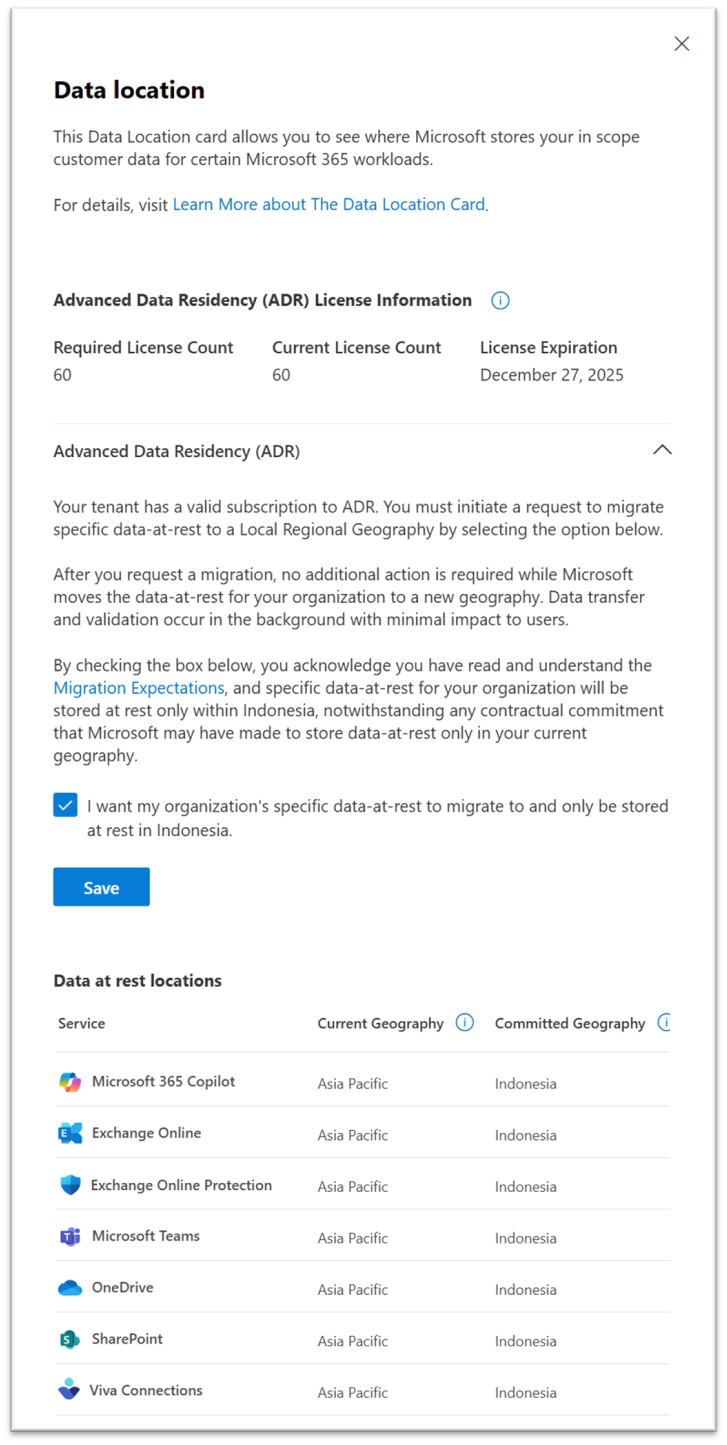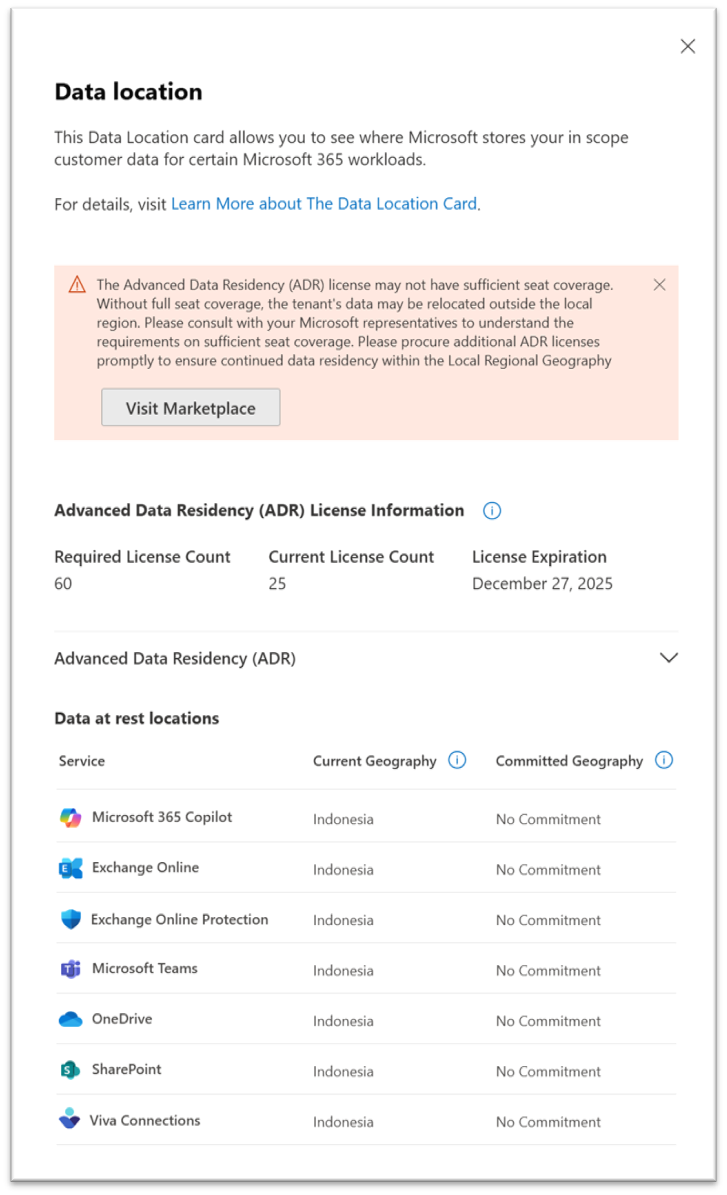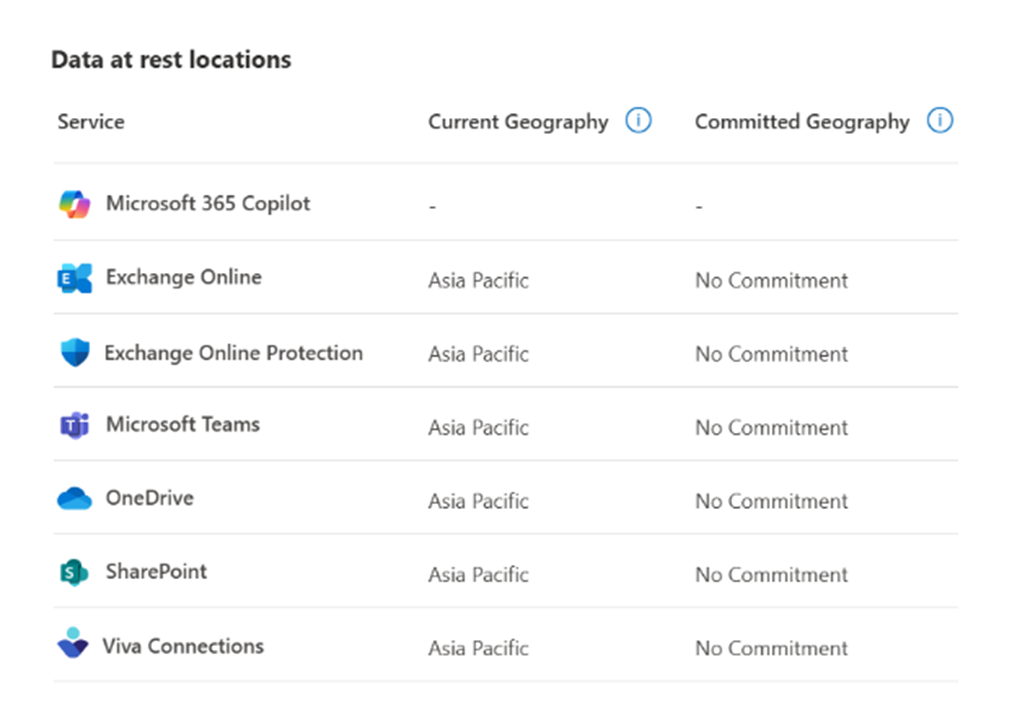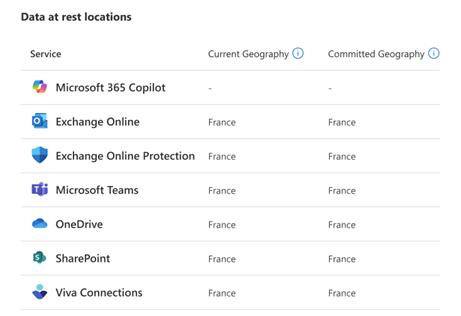Note
Access to this page requires authorization. You can try signing in or changing directories.
Access to this page requires authorization. You can try changing directories.
This article is designed to help customers and Tenant Global Admins understand how they can determine where their in-scope customer data for Microsoft 365 services is currently stored at rest, and if their Tenant has a Durable Commitment on Data Location.
Note
A new Data Location Card (DLC) experience is rolling out now to Microsoft 365 customer Tenants. During the phased rollout, Tenants might see a different Data Location Card view within the Microsoft 365 admin center than the latest enhancements shown in this article. Global Tenant Admins can refer to the following data location details in anticipation of the rollout.
Locating Where your Tenant’s Data is Stored at Rest
The Data Location Card (DLC) in the Microsoft 365 admin center allows Tenant Global Admins to see where in-scope customer data associated with certain Microsoft 365 Core Services and Microsoft 365 Expanded Services is stored at rest. To access the Data Location Card, select the Data location section in the Microsoft 365 admin center by navigating to Admin > Settings > Org settings > Organization profile > Data location.
Overview of the "Data at Rest" Locations
The Data Location Card displays three columns outlining the covered Services, the Current Geography, and the Committed Geography.
The Current Geography refers to the location where the in-scope customer data is currently stored, while the Committed Geography refers to the location where Microsoft stores in-scope customer data based on the data residency commitments applicable to the Tenant.
Finding The Commitments Applicable to a Microsoft 365 Service
Different Microsoft 365 services might be covered by different commitments depending on several factors, including the date of a customer’s subscription, the date that a Tenant was provisioned, the Default Geography of a Tenant, and if Product Terms apply to certain Microsoft 365 services. The data location on the DLC displays the most conservative Durable Commitment on Data Location.
For simplicity, the Data Location Card only shows a single Committed Geography based on a customer’s various commitments for their Tenant.
If a Tenant:
Has an active Advanced Data Residency (ADR) subscription, then the Committed Geography reflects the Local Region Geography that is associated with the ADR commitment.
Doesn't have ADR and qualifies for data residency based on Product Terms, the applicable Geography associated with the Tenant’s Product Terms is listed.
Doesn't have ADR, and doesn't qualify for data residency based on Product Terms, but the Tenant’s Default Geography is in the European Union or EFTA, then the Tenant’s Committed Geography is the European Union/EFTA.
If a Tenant doesn't have any of the preceding conditions, Microsoft stores the in-scope customer data where it best enables Microsoft to provide services to customers, and that data storage location is subject to change without notice. The DLC also displays "No Commitment" in the Committed Geography field.
Understanding Mismatches Between Current Geography and Committed Geography
A discrepancy might appear between Current Geography and Committed Geography in certain circumstances, including the following scenarios:
A customer has procured an Advanced Data Residency (ADR) commitment for their Tenant, and the Tenant Global Admin has not yet opted-in to migration. If a Tenant Global Admin has not yet opted-in to migration, the Data Location Card shows a mismatch between Committed Geography and Current Geography. To rectify this discrepancy, the Tenant Global Admin must opt in to migration and allow sufficient time for the migration to occur (see #2).

A customer has procured an Advanced Data Residency (ADR) commitment on data location for their Tenant and has opted-in to migration. While the Tenant’s Committed Geography is updated to reflect the Tenant’s new commitment, it takes some time for the services to process the request and migrate in-scope customer data to the new location. The Tenant's Data Location Card continues to display a mismatch between Current Geography and Committed Geography until the data migration effort is complete.
Example: A Tenant's Data Location Card displays a Current Geography of "Asia Pacific", but the customer recently purchased ADR for Indonesia for this Tenant. After opting-in to data migration, the Tenant’s Committed Geography is updated to "Indonesia". However, the Tenant’s Current Geography continues to display "Asia Pacific" until the in-scope customer data is migrated. When an individual service completes data migration efforts, the Tenant’s Data Location Card is updated and displays a Current Geography of "Indonesia".

A customer’s Tenant is eligible for data residency based on Privacy and Security Product Terms, but the customer didn't elect to take part in the Legacy Move Program. If a customer’s Tenant is eligible for data residency based on Product Terms, but the Tenant Global Admin didn't elect their Tenant to participate in the Legacy Move Program then the Tenant’s Data Location Card may display a mismatch between the Tenant’s Current Geography and Committed Geography.
Data residency based on Product Terms doesn't include data migration into Local Region Geographies. Tenants remain eligible for a data residency commitment for in-scope customer data associated with Microsoft 365 Core Services in their respective Local Region Geography—once their in-scope customer data is migrated to that location. To initiate migration, customers must purchase the required number of ADR licenses and opt-in to the migration process.

ADR licensing requirements are not met. If a Tenant was once covered by an ADR commitment, and fails to meet the licensing requirements – the Tenant’s Data Location Card reflects this change in the Committed Geography.
Example: If an Indonesian customer no longer meets the required number of ADR licenses needed to retain in-scope customer data in Indonesia, the Tenant’s Committed Geography changes from "Indonesia" to "No Commitment" in their Data Location Card.

A Tenant’s Current Geography for the Microsoft 365 services displays a Local Region Geography, but its Committed Geography displays a Macro Region Geography. In this case, the Tenant’s in-scope customer data is compliant with the Tenant’s Committed Geography. Information about the Tenant’s current data location (that is, Current Geography) is more granular, indicating a specific location or set of locations.
Example: A French Tenant with a Current Geography of "France" and a Committed Geography of "European Union/EFTA". Since "France" is part of the European Union, in-scope customer data is also within the "European Union/EFTA". In this example, "France" is a more specific and detailed location of where in-scope customer data is stored.

No data location is displayed under the Committed Geography field: In this case, information about the Tenant’s Current Geography is accurate, and the Tenant simply doesn't have any Durable Commitment on Data Location.
Example: A Tenant with a Default Geography of Laos, that isn't currently eligible to purchase ADR or Multi-Geo and doesn't qualify for data residency based on Product Terms or EUDB, sees a Current Geography where their in-scope customer data is currently stored, and "No Commitment" in the Committed Geography field.

Microsoft 365 Services without a Current Geography or Committed Geography
If there's no data location shown (indicated by a "-" next to a Microsoft 365 service), a Tenant doesn't currently have an active subscription for this service.
In the following example, the Tenant doesn't have a Microsoft 365 Copilot subscription.

Data Location Card and Microsoft 365 Multi-Geo Capabilities
If a customer has a Microsoft 365 Multi-Geo Capabilities data residency offering, then the new Data Location Card experience reflects only the information related to the Tenant’s central location. This is because the Microsoft 365 Multi-Geo Capabilities offering allows Tenant Global Admins to store data in multiple locations. Information on Satellite Locations isn't disclosed on the Data Location Card. For more information, please see the Microsoft 365 Multi-Geo page
The Tenant’s Data Location Card displays the following message:

Microsoft 365 Services stored in "Europe"
Certain Tenants might have their in-scope customer data stored in "Europe" but might not be provided with the EUDB commitment based on the Tenant’s Default Geography. In these scenarios, users see a Current Geography of "Europe" and an information message stating “This tenant doesn't have an [EU Data Boundary] (EUDB) data residency commitment.” at the bottom of the DLC. For more information on EUDB eligibility, see How to configure services for use in the EU Data Boundary. For more information on EUDB commitments, see the Microsoft EU Data Boundary documentation in the Microsoft Trust Center.
